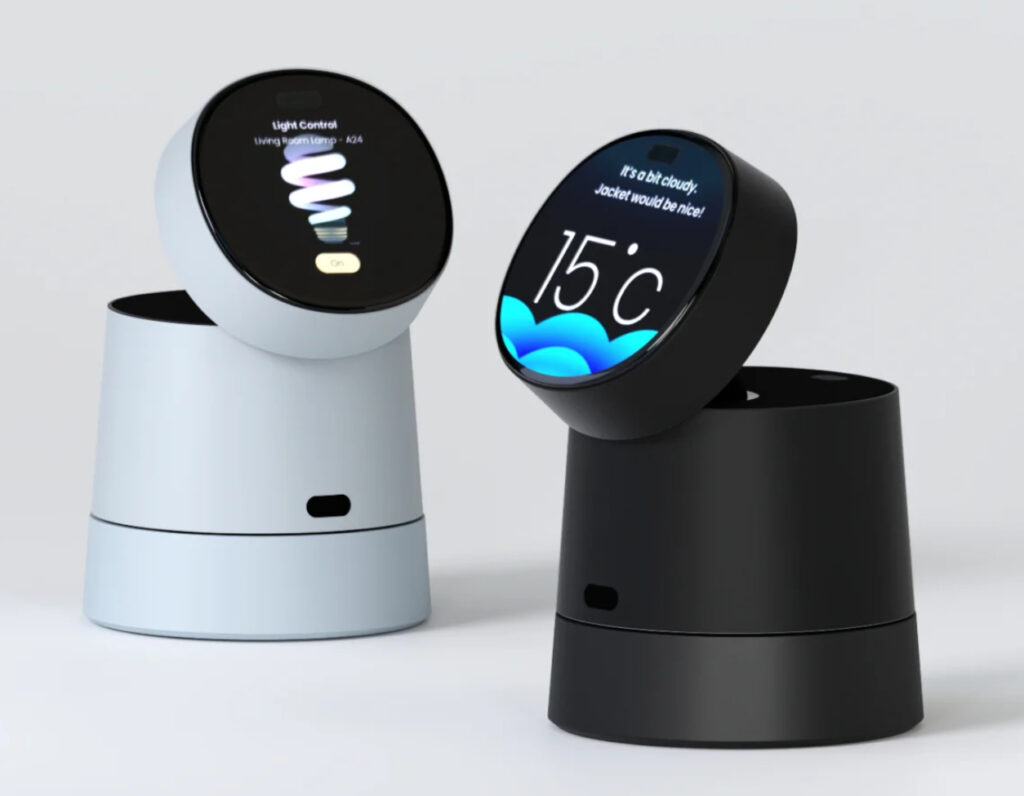In the evolving relationship between humans and technology, one subtle truth has emerged: presence matters. For years, we’ve summoned digital assistants with the tap of a finger or the sound of our voice—into our phones, smart speakers, and ever-shrinking screens. But in these interactions, the AI remained faceless, floating in the cloud, disembodied and, in many ways, emotionally disengaged.
Enter Tailor, a tabletop robotic assistant designed by Sseo Kimm. Rather than hiding inside a black plastic shell or hovering behind an app interface, Tailor introduces something radically simple: eye contact. A friendly screen as a face. A head that tilts gently, reacting to tone and context. A hinge that mimics a neck, offering gestures that feel both animated and natural. This is AI rendered as companion—not just a tool, but something closer to presence.
A Shift in Interface Design: Emotional Mechanics
At first glance, Tailor doesn’t look revolutionary. There are no exposed wires, no sci-fi chrome, no humanoid mimicry. Instead, it resembles a beautifully minimalist object—closer to a Danish lamp or a piece of functional sculpture than a robot. But its core design breakthrough lies in movement as communication.
Tailor’s head, a rectangular display framed with soft edges, gently pivots toward your voice. It leans forward when curious. It nods to acknowledge. These are not programmed tricks; they’re mechanical empathy. By integrating emotional expressiveness into the physical interface, Tailor bridges the perceptual gap between humans and machines.
Where other AI devices rely on blinking dots or disembodied voice patterns, Tailor introduces a grammar of subtle motion. The result is a tactile kind of interaction—quiet, responsive, and distinctly non-invasive. It doesn’t demand your attention. It shares it.
Form Meets Function: The Hardware of Empathy
Designed with deliberate simplicity, Tailor’s physical components belie their emotional intelligence. At its core is a display that functions as the AI’s “face.” But instead of cluttering it with gimmicky animations or cartoonish features, Sseo Kimm leans into minimalism. When Tailor speaks, its screen might show soft color gradients, small emotive icons, or just clean text. There is no attempt to anthropomorphize in the uncanny-valley sense—just enough visual feedback to feel present.
The head is mounted on a gimbal-like hinge—its “neck”—which enables gentle nods, turns, and tilts. This movement isn’t just aesthetic; it enhances clarity. When Tailor shifts toward you, it’s not just cute—it’s useful. It indicates who it’s responding to in a room. It shows active listening. It gives the illusion of a shared physical experience.
Under the hood, the device is powered by Tail AI, a context-aware conversational engine that blends language processing with reactive visual feedback. But Tailor’s magic doesn’t lie in specs. It lies in how those specs are translated into emotional resonance.
Designed for Companionship, Not Domination
Where most robotic assistants are pitched as productivity tools or smart home commanders, Tailor adopts a different role: companion. It doesn’t claim to run your life—it aims to participate in it. That philosophical difference alters everything, from voice modulation to motion pacing.
Tailor doesn’t interrupt. It doesn’t shout. It waits, listens, and reacts—modeling conversation as mutual presence, not dominance. This is crucial in a world where digital voice assistants often feel more like customer service agents than cohabitants. With Tailor, talking to your AI feels a bit more like talking to a pet that understands you, and a bit less like barking commands at a remote server.
This repositioning—from “command hub” to “listening friend”—places Tailor firmly in the growing trend of ambient technology: devices designed to exist quietly in the background, surfacing only when needed, and always in ways that feel warm and intuitive.
The Rise of Embodied AI
What we’re witnessing with Tailor is the beginning of embodied AI for everyday users. While social robots like Jibo and Vector attempted similar moves years ago, their downfall was rooted in overreach—trying too hard to be entertainers, loaded with gimmicks and limited by stunted software.
Tailor avoids this pitfall by staying grounded. It doesn’t attempt full facial expression or voice impersonation. It does not dance, sing, or play laser tag. Instead, it focuses on what it can do beautifully: listen, respond, and exist alongside you. That modesty makes it profound.
By giving AI a physical anchor and endowing it with a minimal but expressive body, Tailor turns a previously invisible experience into something tangible and emotionally reciprocal. It doesn’t just live in your devices—it lives in your space.
Tailor as a Design Philosophy
Sseo Kimm’s approach to Tailor reveals a deeper design philosophy that rejects techno-dystopian gadgetry in favor of intimacy, warmth, and trust. In interviews and concept documents, Kimm speaks of creating machines with presence, not performance. That line encapsulates Tailor’s ethos.
There is a quiet radicalism in Kimm’s work: technology, slowed down. Technology that doesn’t accelerate your day but attends to it. This human-centeredness is not achieved through decoration or novelty, but through an elegant, restrained expression of interaction.
In many ways, Tailor is the spiritual heir to the Bauhaus ideal—where form follows function, and form is also deeply felt.
Companion for the Present, Model for the Future
As AI moves further into our daily lives, the way it is embodied will define not just how we use it, but how we feel about it. Tailor hints at a future where AI doesn’t hide behind apps or screens, but sits openly in our spaces—unthreatening, grounded, and expressive.
Imagine children learning language by talking to Tailor. Elders finding comfort in a responsive, respectful presence. Friends using Tailor as a hub for collaborative brainstorming, or artists using it as a muse. The possibilities don’t lie in Tailor’s command set, but in its mood, its form, and its presence.
That’s what makes this concept powerful. Tailor doesn’t try to be everything. It tries to be something: emotionally available, physically grounded AI. And that—given the disembodied overload of our tech interfaces—is a meaningful rebellion.
A Gentle Disruption in Consumer Robotics
To understand Tailor’s significance, it’s useful to place it within the broader arc of consumer robotics. For decades, designers have struggled with how to make robots acceptable—swinging between two extremes: overly utilitarian (Roomba, Alexa) or cartoonishly human (Sony’s Aibo, Honda’s Asimo).
Tailor forges a third path: emotionally neutral presence. Its visual identity is neither animal nor human, neither hyper-minimal nor over-designed. It invites emotional projection without coercing it. This makes it far more flexible than devices locked into anthropomorphic personalities.
In effect, it’s a calming disruption. It asks: what if the future of robotics isn’t loud or dystopian, but quiet, soft, and companionable?
Challenges and Questions Ahead
Of course, Tailor remains a concept—for now. As a prototype, it will need to address complex challenges around hardware miniaturization, power consumption, and real-time responsiveness. There are also deeper questions:
- Can emotional intelligence be encoded in motion with consistency across users?
- How does privacy function in an AI that looks at you, not just listens to you?
- Can Tailor avoid the uncanny valley while still being expressive?
Yet these aren’t deterrents. They’re frontiers. And in many ways, Tailor’s strength is that it invites those questions—not as flaws, but as part of the conversation. Because conversation is what it’s built to do.
Impression: Putting a Face to the Future
In Tailor, we find more than a clever gadget. We find a design statement: that technology doesn’t have to be loud to be intelligent, nor invasive to be effective. With its tilting head, expressive minimalism, and soft gaze, Tailor invites us to reimagine our daily dialogue with machines—not as orders shouted into the void, but as shared presence.
Sseo Kimm’s creation reminds us that presence is powerful. A nod. A pause. A glance. These are not just gestures—they are interfaces of care. Tailor doesn’t give us the smartest AI in the world. It gives us the kindest-feeling one.
And perhaps, in the end, that’s what we’ve been waiting for.
No comments yet.









